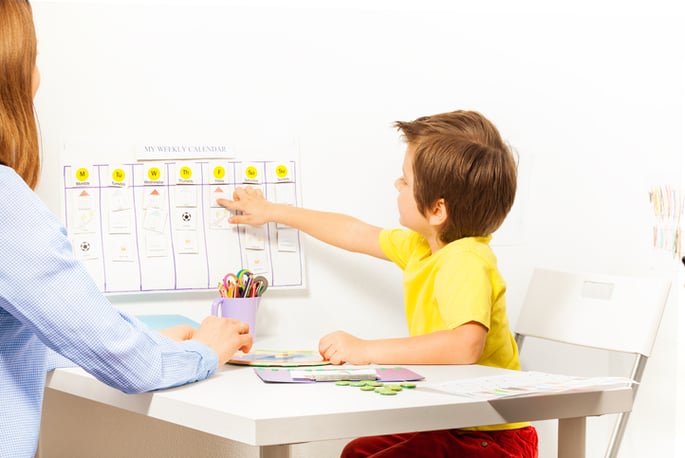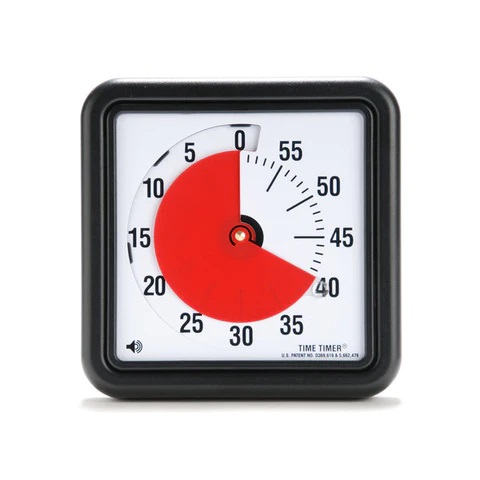Using Visual Supports for Autistic Children
This resource was created as a supplement for the Language Builder: ARIS® Academic Readiness Intervention System's complete early autism curriculum, Lesson #79 Following a Schedule. Download free images of classroom visual schedules to use in your classroom and learn more about the ARIS curriculum.
9 Easy-To-Implement Visual Supports for Autistic Children
Visual supports play a powerful role in our daily lives – from using sticky notes as reminders at work to leaving used batteries out on the counter to remember to buy more at the store. Visual cues offer a go-to method for aiding in the completion of important life skills, tasks, and activities. Even things as simple as creating a grocery list with color-coded sticker icons can be a powerful approach for jogging our memory around tasks that need to be done and items that need to be purchased from the store.
Visual supports can also be an effective strategy for autistic individuals. Because autistic learners often perform best in academic settings when visual prompts, cues, or reminders are used, providing visual aids across multiple environments can be highly beneficial for diverse learners.
The possibilities for creating visual supports are nearly endless. Some helpful ideas to consider include: (1) visual schedules, (2) color-coded signals for noise levels, (3) stop, go, and yield signs, (4) basic gestures, (5) symbols and picture cards, (6) first-then sequences and visual activity boards, (7) charts, graphs, and rating scales, (8) classroom posters, and (9) visual time trackers.
1. Visual schedules
Visual schedules are a common place to start when supporting autistic learners. These schedules provide a tangible reminder, icon, or image to cue the completion of tasks throughout the day. They can also include photos, color-coded cards, or targeted keywords to encourage engagement in the school, work, home, and community settings.
Morning and evening schedules with removable picture icons using velcro, tape, or magnets can be created as well to support various routines throughout the day. Each component of a visual schedule serves as a prompt to aid learners in completing tasks or activities on their schedule.
Moreover, virtual apps from companies like Good Karma allow visual schedules, first-then sequences, and other visual supports to be used on the go. Apps can be used on a mobile device for setting reminders, teaching the concept of time, establishing new routines, assisting with organization, helping social stories come to life, and more.

2. Color-coded signals for noise levels
Color-coded signals–like green, yellow, and red paper signs–can be implemented in the classroom, lunchroom, computer lab, and library setting throughout a school to prompt students to stay within appropriate noise ranges for those areas.
When using a color-coded system for noise levels, students should be taught to identify a green signal as being within a good noise level. If an instructor changes the signal color to yellow, students should heed that as a warning that they are getting too loud and need to quiet down their voices. Finally, if the color is changed to red, students should be instructed to stop talking so that they can return to an appropriate level of volume for the area they are in.
Consequences can be implemented for reaching the red signal but should be explained to students before reaching that zone. A sound or tone can also be paired with the switching of colors from one level to the next.
3. Stop, go, and yield signs
Educators may find stop, go, and yield signs to be an effective approach for appropriately managing classroom transitions. At the beginning of the school year, for example, students should be taught the meaning of each visual sign before teachers begin using them across different classrooms.
An educator might teach their students to prepare for a transition from one activity to the next by using a yellow yield sign paired with the words “get ready to go” or “slow down.” Yield signs can help teach students to wrap up their current activity to transition to the next one within a few minutes.
Additionally, a stop sign–coupled with the words “line up” or “time to go”–can be used to signal the transition from one task to the next. Stop signs should be viewed as a hard and fast signal to stop the current activity and quietly line up in a straight line.
Finally, a green “go” sign may be implemented to instruct students to leave the classroom, follow their teacher’s lead, and use inside voices while walking silently in line. Educators might also pair simple words like “let’s go” or “walk quietly” with the green sign they use.

Basic gestures are another useful strategy for visual support. Teaching students to recognize and use basic gestures is important in both the real-world setting as well as in the academic environment. Learners can be taught to shake their heads up and down to answer “yes” or left to right for “no.”
Furthermore, a simple thumbs-up can indicate approval while a thumbs-down indicates disapproval or dislike. When a student is unsure how to answer or does not have an opinion, a shoulder shrug or thumb pointed horizontally in the middle may be used to designate that.
5. Symbols and picture cards
A picture exchange communication system (PECS) can be used to teach basic language skills to autistic learners who do not speak vocally. Picture noun cards, for instance, are a great place to start as these cards can be used to request or name certain items. Visual cards are especially helpful for expressing one’s needs, wants, and desires if the learner is nonverbal.
Visual cards can also be used as labels throughout the home and school environment to help students learn where to ask for various items. The family fridge, for example, could have images of the food that is inside it while certain cabinets in a school classroom might be labeled with a picture card for bubbles, games, and toys respectively.
6. First-Then sequences and visual activity boards
Cork pin reminder boards, first-then sequence cards, and visual combination layouts can be used to cue the completion of tasks in a specific order. These strategies are also useful for visualizing task activity chains in chronological order, and autistic learners may find it helpful to have tasks laid out in a first-then sequence.
Activity cards for completing homework, doing the dishes, and walking the dog can be placed in chronological order on a table or desk to provide a visual representation of the tasks that must be completed before free time is earned. To watch television or play outside with the neighbors, for example, Sam must first finish his homework, do the dishes in the sink, and take the dog outside. After completing those responsibilities, he can then participate in more enjoyable activities like playing outside or watching his favorite show. Choice boards can be created as well by laying out pictures of games, tasks, or activities for a student to choose from.
The first-then principle is a popular visual strategy that can be easily implemented when task cards are laid out in chronological order. Picture cards can also be used in combination with a cork activity board for representing visual reminders. After completing all of the necessary tasks in the sequence, learners earn rewarding activities, like time with friends or a favorite piece of candy. This is an effective system for encouraging positive behavior both at home as well as in the classroom.

7. Charts, graphs, and rating scales
Progress reports can be formatted into graphs or charts that allow parents, students, therapists, and other educators to easily visualize a learner’s academic achievements throughout the school year. Numerical data–such as grades ranging from 0% to 100% for each class–can be charted in a graphical format that provides easy-to-visualize data on a student’s progress. Additionally, a visual representation of data can be aggregated for an entire class or school of learners to create an overview of academic results.
Emotional and behavioral rating scales may also be used to teach autistic learners to recognize, identify, and appropriately respond to their attitudes, thoughts, behaviors, and emotions. Labeling, naming, and acknowledging emotions is an essential skill, and it should be taught in school, at home, in therapy, and in the real-world setting at large.
8. Classroom posters
Classroom posters are another strategy that can be used as visual reminders for students. Posters might contain simple information–such as pointers for how to properly wash one’s hands in the bathroom before returning to class or how to be safe in a fire. In either case, emphasis should be placed on providing simple, visible instructions that are easy to follow and understand according to the learner’s level of development.
Consider providing basic written instructions along with picture demonstrations as a visual component. For best results, use the posters as a teaching activity by walking students through each step and incorporating planned practice sessions. Then, for subsequent hand-washing or fire drill situations, students can apply their knowledge by following the directions on the poster independently. If needed, basic prompts or short verbal cues can be used to guide students through the steps until mastery is achieved.
9. Visual time trackers
Finally, time trackers can be a helpful method for visually demonstrating how much time remains–or has elapsed–since the start of a task, activity, or class. These trackers can be virtual (such as on an iPad app), or physical like this timer or a sand timer. Students can be taught to read analog clocks as well to give them a tangible concept of how much time remains until the end of class.

Visual supports are a valuable tool for many autistic individuals. When developing effective visual strategies, it is important to ensure that supports are sufficiently individualized, durable, easy to use, and versatile. Because autistic students tend to be visual learners, instructions, cues, guidelines, and directions with visual components are often highly beneficial.
What are some additional ways to integrate visual supports for autistic students in the classroom setting?
We hope you enjoyed the information in this article. STAGES® Learning also offers free downloadable resources to support teaching autistic individuals. Start with our free Picture Noun Cards and see our collection of other downloadable resources here!
This article was based, in part, on the following sources:
https://www.autismparentingmagazine.com/benefits-of-autism-visual-supports/
http://card.ufl.edu/resources/visual-supports/
https://www.autismspeaks.org/sites/default/files/2018-08/Visual%20Supports%20Tool%20Kit.pdf

Kenna McEvoy
Kenna has a background working with children on the autism spectrum and enjoys supporting, encouraging, and motivating others to reach their full potential. She holds a bachelor's degree with graduate-level coursework in applied behavior analysis and autism spectrum disorders. During her experience as a direct therapist for children on the autism spectrum, she developed a passion for advocating for the health and well-being of those she serves in the areas of behavior change, parenting, education, and medical/mental health.




